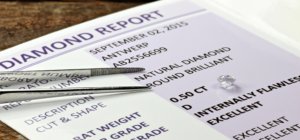 What is a Gemstone Certificate?
What is a Gemstone Certificate?
A gemstone certificate can be a wonderful comparative tool. But what exactly is a “cert” and why should you get one? With all the different gemstone treatments in use today, a detailed evaluation of your gemstone will be a great asset if you need your gemstone appraised or if you plan to sell it. It can also clear up a lot of questions that you might have about gemstone treatments. Here you will find information on the different types of gemstone treatments, how they are reported on a cert, and what gemstone certification actually means.
A gemstone certification is a written report, sometimes but not always accompanied by a photograph or diagram. It will have an assigned number and emblem of the testing facility. The gemstone certification report is prepared by a gemological testing laboratory and represents the conclusions of one or more trained gemologists who identify and describe the gemstone under controlled conditions with combination of scientific analysis and expert evaluation. There is an element of subjectivity based on the opinion of the grader through direct observation.
Any gem treatments discovered during evaluation are recorded on the report.
How do you read a gemstone certificate?
Here are some abbreviations you are likely to see and their meanings:
N: Natural gemstone not enhanced.
E: Enhanced gemstone using common accepted treatments (for example, heat treating for sapphire and rubies or oiling for emeralds).
I: A non-traditional enhancement was used (such as flux or lead glass filling in rubies).
B: Indicates the gemstone has been bleached or lightened.
C: The gemstone has been coated with a substance to alter its appearance or achieve a desired effect.
G: Irradiated gemstone by gamma or electron bombardment.
H: The gemstone has been heat treated.
L: Indicates laser drilling to remove dark inclusions in diamonds.
O: The gemstone has been oiled.
R: Irradiated gemstone by neutron bombardment.
S: Indicates a bonding element has been introduced to give the gemstone durability.
U: A diffusion treatment was used to alter the appearance of the gemstone.
W: Wax or oil is used to improve a gemstone’s appearance
Remember that a natural, untreated gemstone will be far more valuable than a treated stone because natural untreated gemstones are very rare. Understanding the difference not only between natural gemstones and treated gemstones but also differences in the acceptability of the treatments themselves can provide you with the ability to make smarter buying choices.
In addition to enhancement codes, you will also see information regarding specific inclusions, or internal characteristics, of your gemstone. Natural inclusions are often indicative of the country of origin of the gemstone. The country of origin may be listed as well and is usually noted alongside any telltale inclusions that are consistent with gemstones of a particular region. If the certificate is for a diamond, you will see a plot. A plot is a detailed drawing of the internal and external characteristics of the diamond. It is less common for a colored gemstone to be accompanied by a plot. A photograph of the actual colored gemstone is in wider use than the plot.
You will also see a specific weight to the hundredth of a carat as well as precise measurements to the hundredth of a millimeter. These data can prove very useful if the gemstone is ever stolen and then recovered. A certificate can prove ownership of the gemstone. Measurements will include the average girdle diameter, or length and width if the gemstone is not round. You may also see the length to width expressed as a ratio: this is indicative of the quality of the cut. A grade or evaluation of the quality of the cut and not just an iteration of the gemstone’s shape will also be included. Color is described verbally or expressed as a grade.
Obtaining a certificate for a gemstone can be a lengthy and costly process. Many vendors will provide a truncated report as an added value to the sale. An in depth report can take weeks to obtain and can cost hundreds of dollars. This is something to consider when planning your purchase. You would be well advised to postpone finalizing a sale pending the results of the certification. If a gemstone is not certified, and is revealed to be inconsistent with the seller’s description, you may want to re-think your purchase or negotiate a better price.
Would a gemstone certificate impact your decision to buy? We are curious if you think certificates are important or not. Did you buy a certified gemstone, or did the vendor offer to provide one? Tell us about your experience. We want you to share your knowledge with our readers!
Read more posts from the Gemstone Buying Guide series
